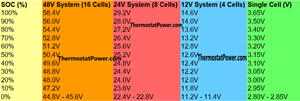The nominal voltage of LiFePO4 batteries, typically 3.2 volts per cell, is a fundamental characteristic that affects their performance, integration into electronic systems, and overall usability. This voltage provides a balance between safe operation and efficient energy delivery.
Nominal voltage is essentially the average voltage of a battery cell during its discharge cycle. For LiFePO4 batteries, this value is typically 3.2 volts per cell. It represents the voltage at which the battery can be expected to operate for a significant portion of its discharge cycle, rather than its peak or minimum voltage levels.
LiFePO4 batteries have a unique electrochemical composition that gives them distinct voltage characteristics. When fully charged, a LiFePO4 cell has a voltage of around 3.6 to 3.65 volts. As the cell discharges, the voltage gradually decreases to its nominal value of 3.2 volts. Towards the end of its discharge cycle, the voltage drops more rapidly, usually down to a cut-off voltage of about 2.5 to 2.8 volts. The nominal voltage of 3.2 volts reflects the point at which the battery provides the most stable and efficient performance during the majority of its discharge cycle.
Importance of Nominal Voltage in Battery Applications
Battery Pack Configuration: The nominal voltage is a critical factor when designing battery packs. For example, if a 12V system is required, using a 4-cell LiFePO4 battery pack would be appropriate since four cells in series would give a nominal voltage of 12.8 volts (4 x 3.2V). This configuration is especially common in solar power storage, electric vehicles, and backup power systems where stable and reliable voltage is essential.
Compatibility with Electronics: Many electronic devices and systems are designed to work with specific voltage ranges. Understanding the nominal voltage of LiFePO4 batteries ensures that they can be matched correctly with the devices they power. Using the appropriate nominal voltage reduces the risk of over-voltage damage or insufficient power delivery.
Charging Systems: The charging voltage of a LiFePO4 cell needs to be higher than its nominal voltage to fully charge it. Typically, LiFePO4 cells are charged to around 3.6-3.65 volts per cell. Knowing the nominal voltage helps in setting up the right charging parameters, ensuring the battery is safely and effectively charged.
Energy Management: For energy storage systems, knowing the nominal voltage allows for better management of charge and discharge cycles. This knowledge aids in estimating the battery’s state of charge (SoC) and in designing power management systems that can handle the voltage variations throughout the battery’s cycle.
Comparison with Other Lithium-Ion Batteries
LiFePO4 batteries are often compared with other lithium-ion chemistries, such as Lithium Cobalt Oxide (LiCoO2) or Lithium Manganese Oxide (LiMn2O4). Here’s how the nominal voltage of LiFePO4 compares to other lithium-ion batteries:
LiFePO4 (Lithium Iron Phosphate): Nominal voltage of 3.2V per cell.
Li-Ion (Lithium Cobalt Oxide): Nominal voltage of 3.6 to 3.7V per cell.
Li-Ion (Lithium Manganese Oxide): Nominal voltage of 3.7 to 3.8V per cell.
The lower nominal voltage of LiFePO4 cells compared to other lithium-ion chemistries is compensated by their higher cycle life, stability, and safety features. This makes LiFePO4 batteries particularly well-suited for applications where long-term durability and safety are prioritized over maximizing energy density.
Why the Nominal Voltage of LiFePO4 Batteries Matters in Everyday Use
When integrating LiFePO4 batteries into a system, the nominal voltage is crucial for ensuring compatibility with the system’s operating voltage. For example, in off-grid solar power systems, LiFePO4 batteries are often chosen due to their 12.8V nominal voltage for 4-cell configurations, which aligns well with traditional 12V lead-acid battery systems. This makes it relatively simple to replace older battery technologies with LiFePO4 batteries without extensive modifications to the system.
Additionally, electric vehicles (EVs) and portable power devices often use LiFePO4 batteries due to their stable nominal voltage and robust cycle life. The stable voltage output during most of the discharge cycle helps in maintaining consistent power delivery to the motor or device, improving efficiency and performance.
